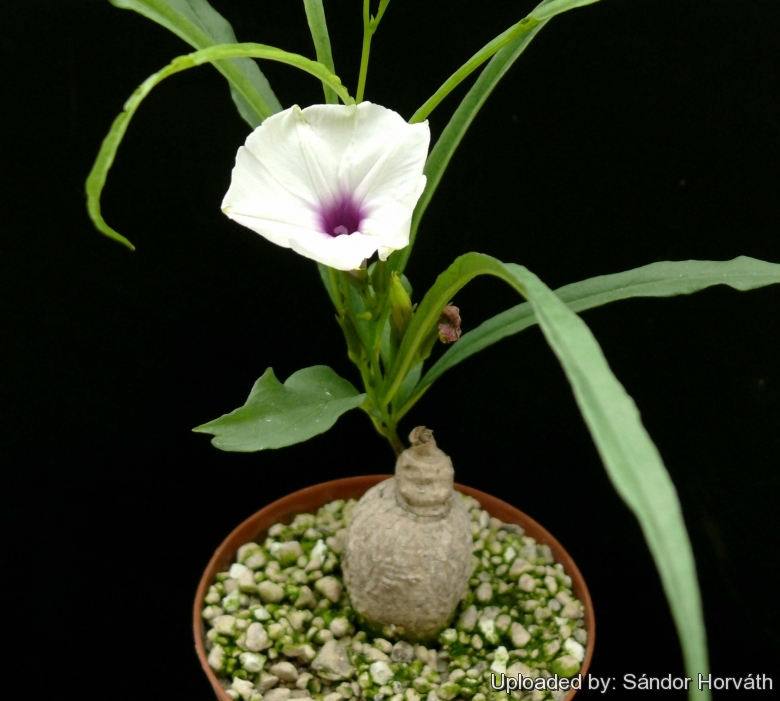
Ipomoea lapathifolia Photo by: Sándor Horváth
Origin and Habitat: Ipomoea lapathifoliaSN|32248]]SN|32248]] is widespread from Tanzania, Uganda, Democratic Republic of the Congo, Zambia, Malawi, Zimbabwe, Namibia and Mozambique to northern Botswana, Swaziland, South Africa (KwaZulu-Natal, Limpopo, Mpumalanga).
Altitude range: Mainly between 155 and 610 metres above sea level.
Habitat and origin: This species grows in wet areas in woodland, savannah, andfloodplain grassland areas on heavy black clay soil, also along roadsides and in disturbed places.
Synonyms:
See all synonyms of Ipomoea lapathifolia
Description: Ipomoea lapathifoliaSN|32248]]SN|32248]] is a perennial herb with twining or semi-prostrate stems up to 3 m long from a thin succulent taproot. It is distinguished by its slightly fleshy leaves, closely umbellate cymes and corollas with long, cylindrical, white to mauve/magenta tubes.
Tuberous taproot: Thin spindle shaped.
Annual stems: Several, slender, or prostrate, up to 3 m long, but usually short and little brancked, glabrous to hairy puberulous or sometimes hirsute and ridged.
Leaves: Herbaceous slightly fleshy drying papery, usually entire, variable in shape. Leaf lamina broadly-ovate, lanceolate or very narrow linear, (4-)6.5-12.5(-18) cm long, (0.5)2.5-5.5(-7) cm broad, obscurely pubescent on both surfaces, Base cuneate rounded to truncate, coarsely sinuate-dentate or with small lobes. Apex mucronate, obtuse to subacute, green above, paler below, glabrous to thinly hairy, margin entire or more or less sinuous. Petiole (5-)10-40(-70) mm long, minutely scabrid to hirsute.
Flowers: Few to many (3-12) in a close umbellate cyme. Peduncle (10-)35-11(-150) mm long. Bracteoles 1-3 mm long, minute, early caducous or more or less persistent, ovate or lanceolate. Pedicels at most 20 mm long. Calyx glabrous, c. 6 mm long. Sepals unequal, subcoriaceous, outer ones triangular to oblong, 6-7 mm long, finely muriculate or verrucose on back; inner ones oblong to ovate, 7-8 mm long, smooth, with a broad, hyaline membranous edge; all slightly accrescent and glabrous. Corolla glabrous white 3-4.5 cm long. Corolla tube subcylindric 20-40 mm long, mauve with fine purple striations outside, magenta inside except for a white zone below insertion of stamens. Expanded limb funnel-shaped, 25-35(-40) mm in diameter, pure white with yellowish green, well-defined midpetaline areas, shallow. Filaments and style white, anthers and stigma pink.
Fruits (capsules): globose, glabrous, 6 mm in diameter.
Blooming season: Flowers open at night in December to February and are short lasting.
Seeds: Glabrous, brown, 3 mm long.
Bibliography: Major references and further lectures.
1) J. G. Baker and A. B. Rendle “Flora of Tropical Africa” Vol IV, Part 2, page 62, 1905
2) J.P. Roux “Flora of South Africa”, 2003
3) African Plants Database (version 3.4.0). Conservatoire et Jardin botaniques de la Ville de Genève and South African National Biodiversity Institute, Pretoria, "Retrieved 07 January 2016 ", from <http://www.ville-ge.ch/musinfo/bd/cjb/africa/>.
4) Kamundi, D.A. 2005. "Ipomoea lapathifolia Hallier f. var. lapathifolia." National Assessment: Red List of South African Plants version 2015.1. Accessed on 2016/01/08
5) B. Verdcourt “Flora of Tropical East Africa” 1963
6) Maria Leonor Gonçalves “Flora Zambesiaca” FZ, Vol 8, 1987
Cultivation and Propagation: Ipomoea lapathifoliaSN|32248]]SN|32248]] is easy to grow and puts on a fanciful display, but it takes years to develop and is not a plant for the impatient gardener.
Light requirements:* Give it plenty of sun or high interior lighting and freely circulating air, but keep the caudex bulb shaded.
Soil: It needs a well-drained soil mix (e.g. use a mixture for cactus + normal potting soil) with the caudex planted largely above the soil surface. A clay pot is best. It can be planted “on” the ground, it will root soon, and the chances of getting rot are smaller this way rather than planted underground (although it grows more slowly).
Water requirements: It needs regular watering during the active growing season without too much water. Let the soil become rather dry before watering again. Stop watering gradually when the stalk dries out after blooming in summer, or else the caudex may rot. During the winter months, the plant will drop all of its leaves and no water should be given during this period. Start watering when the stalk starts growing again in late winter.
Fertilization: If fertilizer is used, it should be diluted to ¼ (one-quarter) the recommended rate on the label.
Hardiness:* It is a frost tender species that must be protected in the greenhouse over the winter (Avoid any frost!). If grown in the home environment, the ideal temperatures should run between 20° to 30° C with winter time temperatures around 10°C. Protect from heat in summer.










